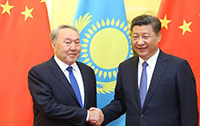China-EU ties fashion green future
By Cecily Liu (China Daily Africa) Updated: 2015-10-30 07:33Such an understanding would help avoid problems such as the dispute over the EU's setting of tariffs for China's low-cost solar panel exports to Europe, he says. Mabey says the panels benefit the EU by providing consumers with an inexpensive, environmentally friendly way to generate energy.
Mabey says it is important to align the objectives of the EU's reform plans and China's 13th Five-Year Plan (2016 - 2020), turning the strategic alliance into "opportunities rather than sources of tension."
In June, E3G published a research paper in cooperation with Chatham House on enhancing engagement between China and the EU on resource governance and low carbon development. The basis for the paper is the growing economic interdependence of China and Europe, because they are both vulnerable to climate change and both have experienced a rise in the number of extreme weather events in recent years.
Given that China and the EU are the world's largest importers of natural resources, and forecast to rely on imports for an estimated 80 percent of their oil supply by 2030, fluctuations in resource prices will greatly affect both.
Suggestions for cooperation given in the report include an increasing focus on existing China-EU partnerships such as energy security, in which the two sides can form a consumer alliance with more cooperation on renewable energy.
It is also suggested the two sides deepen their economic integration and reform through green growth, which could involve continued market integration, policy coordination and consultation, and stronger practical cooperation and regulation.
Furthermore, the two governments are encouraged to work toward a stronger climate change regime, and the establishment of an EU-China working group on climate change governance.
In 2007 Chatham House and E3G published a joint report called Changing Climates, which suggested that cooperation between China and the EU should be deepened to include strategic and long-term clean energy research, development and demonstration, joint standard setting, green trade and investment liberalization.
Since then, there has been an acceleration in the clean energy market. As recommended in Changing Climates, low carbon zones have been established at several levels in China, affecting 350 million people. Jilin city is the first to be established, and since then there have been others. Eight low carbon pilot cities and five pilot provinces are located across the country, and plans focus on reducing carbon in industry, transportation and other areas. Low-emission trading pilot projects have also been established and supported by European technical assistance.
Meanwhile, demand created by European renewable energy policies has created a big push for China's renewable energy industries and exports, and this has brought major reductions in global costs, especially for photovoltaics and light-emitting diodes.
However, such cooperation has met challenges, especially since 2007, such as EU complaints about low prices for Chinese exports such as efficient light bulbs and solar power subsidies.




